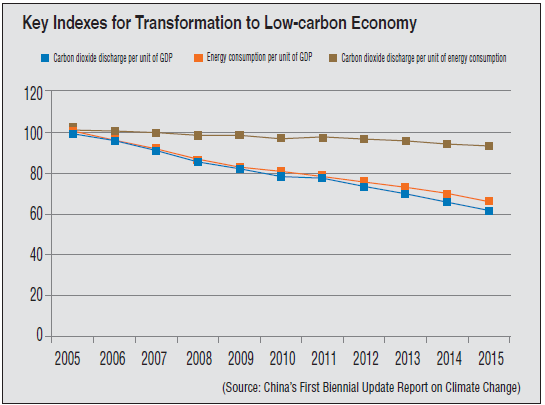Developing a Green Economy in Response to Climate Change
China Today,October 13, 2017 Adjust font size:
Climate change is a global issue. The spike in carbon dioxide emissions worldwide incurred by burning fossil fuels has hampered the sustainable development of the world’s economy, society, and eco-environment, and consequently prompted nations all over the world to transform their growth patterns towards low-carbon.
Low-carbon development is vital to addressing climate change. Scientists have corroborated the legitimacy of climate change, and the significance and urgency of the issue are widely acknowledged. In this context, the notion of low-carbon development is spreading fast, and endorsed by the international community. The solution to climate change lies in low-carbon development, and the threat of climate change is the strongest motivation for low-carbon development.
Government Support
Green development is an obligation that China, along with the rest of the world, is eager to meet to grapple with climate change. It is also demanded in light of the country’s sustainable growth. With guiding policies, relevant institutions, and practical experiences all in place, the conditions for developing a green economy are ripe for China.
China sees a valued opportunity to transform its economic growth pattern in fighting climate change and nurturing a low-carbon economy, which also serve its goal of advancing ecological progress. Its 13th Five-Year Plan (2016-20) articulates that China will explore the establishment of a mechanism to control both the intensity and volume of carbon emissions during this period.

Huanghai Forest Park in Dongtai City, Jiangsu Province, source of the city’s “green oxygen.”
In 2007, the National Leading Group to Address Climate Change was established to lead the national program in this regard. The National Development and Reform Commission (NDRC) was vested to undertake the general work concerning climate change, and relevant departments and governments at various levels take corresponding accountabilities. People from all walks of life are also encouraged to participate. The powers and responsibilities are explicitly divided between regional governments and administrations to realize specific emission reduction goals.
Remarkable progress has been made in this aspect so far. By 2015, China’s carbon dioxide emissions per unit of GDP had slumped by 38.6 percent from that of 2005 and 21.7 percent from 2010 (Chart 1). The fall in greenhouse gas discharge was also noticeable for this period.


In 2015, non-fossil fuels’ share in China’s consumption of primary energy had climbed to 12 percent (Chart 2), surpassing the 11.4 percent goal set in the nation’s 12th Five-Year Plan. China is advancing low-carbon development on all fronts through overarching planning, institutional support, infrastructure, capacity building, and pilot programs, which all lay a solid foundation for climate change adaptation.
Challenges and Opportunities
In the experience of industrialized countries, like Germany and the U.K., low-carbon development began with reflection on the frustration of sustainable development under industrialization. This self-reflection led to innovation in technologies and institutions, transformation of human production and consumption, as well as efforts to lower carbon emissions by using green energies.

Tencent Chairman and CEO Pony Ma (left) and Party Secretary of Hefei City Song Guoquan co-launch the Tencent QR code for bus passes on September 13, 2017.
Developing countries face dual tasks – eschewing the high-consumption, high-emission, and high-pollution approach of industrialization that many developed countries took, and striking a balance between economic, social, and environmental progress. They must explore a new paradigm that allows them to modernize at a relatively low carbon emission level. Compared with their developed peers, China and other developing countries have huge innovation and transformation potentials to develop a low-carbon economy. The tasks and challenges facing them in this aspect, however, are manifold.
The general trend of global development, the orientation of China’s overall strategies, and the traits of China’s urbanization all open up good opportunities for the country’s low-carbon development. On a global scale, the green trend has taken off. The Paris Agreement passed at the 2015 UN Climate Change Conference embodies the broadest consensus of the international community on limiting global warming, and expresses their commitment to green development. Changing to low-carbon development is an irreversible trend, and all countries should jump on the wagon.
At the national level, China has formulated national strategies that chart the course for green growth. At the 18th CPC National Congress, making ecological progress was listed as one of five goals in building Chinese socialism, along with economic, political, cultural, and social progress. Under this guidance, China sets targets to limit the volume of carbon discharge in a bid to nurture low-carbon production and consumption modes, optimize industrial and energy structures, and improve energy efficiency. This is expected to create a synergistic effect between low-carbon development and environmental protection that will further boost China’s ecological progress.
Regionally, the ongoing new-type urbanization in China has set the stage for its low-carbon development. A review of the nation’s urbanization history reveals that the creation and expansion of cities invariably came at the cost of high carbon emissions. At present, cities and towns emit 90 percent of the national total for carbon dioxide. There is huge scope for slashing energy consumption in urban construction and daily life. Starting from the 12th Five-Year Plan period (2011-15) China has carried out low-carbon urbanization pilot programs in many provinces, cities, towns, districts, and communities, as well as in transportation and other sectors, which all contribute to the nation’s climate change adaptation and low-carbon development.
The penalties of the carbon-intensive model of development are now pronounced, but the obstacles to pursuing sustainable development are steep. First, it is hard to overcome the lock-in effect of the old high-carbon development pattern. The six energy-intensive industries, including oil refineries, nuclear fuel processing, chemical industry and nonmetal mineral products, account for one third of China’s industrial output, and three fourths of the total industrial energy consumption. The lock-in effect of high-carbon industries and associated infrastructures cannot be ameliorated over a short period. Meanwhile, accelerated urbanization and rising living standard in China will contribute to higher carbon emissions in the coming years.
Second, low-carbon development calls for a sound legal system. Global experience testifies that low-carbon development, as a long-term development strategy of a nation, should be made into laws to give it an institutional guarantee. China, so far, has no such national statutes. And the existing industry-wide regulations are not sufficiently legally binding. What’s more, a policy system must be established to provide institutional support for low-carbon development in the future.
Third, the nation needs to gain a full and correct understanding of low-carbon development. Certain local governments and businesses have not grasped the full imperativeness and importance of low-carbon development, and still hold fast to certain misbeliefs, such as that low-carbon development stifles economic growth. As for the general public, most consumers cannot wean themselves off their old consumption habits, which lead to high energy use and discharges. The education of the public has to be continued and enhanced.
Green development is in the interest of people’s wellbeing and the future of the nation. It is needed for China’s realization of the “two centennial goals,” and meshes with the country’s strategies of transforming its economic growth mode, adjusting economic structure, and propelling the new industrial revolution. As the world’s largest developing country, China takes on multiple missions – boosting economy, eliminating poverty, improving people’s livelihood, preserving the environment, and coping with climate change. Despite difficulties and challenges on the path of low-carbon development, China, as President Xi Jinping declared, will adhere to the strategy of a sustainable, green, and circular development model, and the basic state policy of saving resources and preserving the environment. China will advance low-carbon development at home through substantive acts, and meanwhile join global efforts to boost sustainable development worldwide.
FAN XING is an assistant researcher at National Center for Climate Change Strategy and International Cooperation.